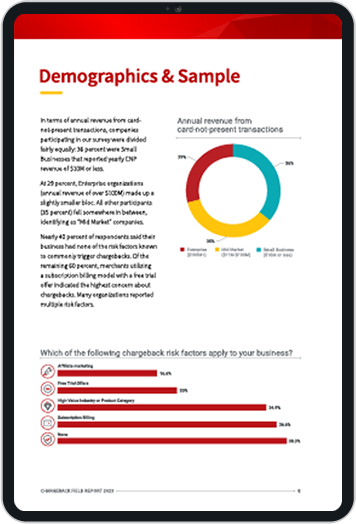Wardrobing: How to Stop Buyers From Using & Returning Your Goods
At its core, wardrobing is a form of first-party fraud. It happens when a shopper buys an item that they intend to use or wear just once, then return it to get their money back.
This is actually a pretty common occurrence. According to the National Retail Federation, return fraud scams like wardrobing (among others) are estimated to cost the retail industry $12.6 billion in lost sales each year.
This is just one return fraud tactic; others like tag switching and refund services are growing concerns, too. We have a full article about different return fraud attack methods, which you can check out here. Today, though, we're going to focus specifically on wardrobing and the threat it poses for retailers.
What can merchants do to protect their businesses from this fast-growing retail threat? Let’s take a closer look.
Recommended reading
- The Top 10 Prepaid Card Scams to Watch Out For in 2025
- Credit Card Shimmers: Are You Prepared for “Skimming 2.0?”
- How do Banks Conduct Credit Card Fraud Investigations?
- Fake Google Reviews: How to Identify, Remove & Prevent
- What is Third-Party Fraud? Tactics, Red Flags & Prevention
- How New Account Fraud Works: Red Flags & How to Prevent it
What is Wardrobing?
- Wardrobing
Wardrobing is a type of return fraud committed by legitimate shoppers who buy wearable or usable items with the intention of returning them after use. For example, an expensive outfit that is worn once then returned, or a book that is returned after reading.
[noun]/wôrd • rōb •iNG/In short: if a person buys something, with the intent of using it then returning it, that's a case of wardrobing.
Unfortunately, this new trend in fraud is becoming quite popular with the public. A recent study discovered that one in five shoppers have engaged in wardrobing at some point. As many as 43% of shoppers aged 16-24 will continue the trend in the future.
These numbers add up. According to an NRF survey, merchants collectively rack up $166 million in merchandise returns for every $1 billion in sales. The average seller also loses $10 to return fraud for every $100 of returned merchandise accepted. Wardrobing, in particular, can have a profound impact on your bottom line, as we’ll see in the next section.
The Financial Impact of Wardrobing
Wardrobing leads to higher labor costs, makes inventory forecasting more difficult, and impacts the environment negatively. Data suggests that fraudulent return behaviors, including wardrobing, cost merchants over $100 billion in 2023.
Some shoppers believe that wardrobing is a victimless crime. Merchants get their inventory back, and buyers get a refund. On the surface, it seems like an equitable exchange. No harm, no foul, right?
The problem is that it’s difficult for merchants to sell items at full price once they’re returned. Fewer than half of all goods returned to retailers actually make it back on the shelf at full price.
According to the National Retail Foundation, merchants received $743 billion worth of returns, and lost $101 billion to return fraud in 2023.

Simply put: shoppers don’t want used goods. Items that have clearly been used, particularly clothing, often can’t be resold for full value. Often, to resell these items, they must be displayed on a discount or clearance rack, and priced at half (or even less) of the original price. Plus, items returned out-of-season, such as holiday gear, are difficult to resell, and any that have stains, tears, or odors often cannot be resold at all, even on clearance.
Other consequences of wardrobing include:
Higher Labor Costs
With an influx of returned items, a merchant would need to allocate resources to figuring out a plan for reselling goods, as well as processing and fulfilling the orders in question. Costs are bound to go up. Additionally, each item that is returned needs to be inspected before it can be returned to inventory.
Inconsistent Inventory
It’s harder to predict which items will be in stock if a merchant is busy managing returns. They may end up with a shortage of one item, then suddenly have an excess of the same goods, which makes it harder to plan inventory in advance.
Environmental Problems
Billions of dollars’ worth of returned merchandise winds up in landfills in the US every year. Sustainability is something that many merchants and consumers can agree is extremely important. Yet, the 40% of consumers who are engaging in wardrobing ignore this every time they commit return fraud for frivolous reasons.
This proves that wardrobing and other forms of return fraud are not harmless at all. It’s also not a problem limited to merchants. The practice will come back to bite consumers with higher ticket prices and lower inventory later on.
How to Identify a Case of Wardrobing
Shoppers who habitually return items that are missing tags or which appear worn could be committing wardrobing fraud.
As we mentioned above, wardrobing is a serious problem that is getting worse every year.
In our increasingly digitized and instant-gratification-seeking economy, merchants and retailers must consistently raise the bar to attract and retain customers. One of these might be a “no questions asked” return policy, or at most, a “limited questions asked” policy.
Whatever the case may be, the onus to detect and resolve a wardrobing situation is going to rest solely with the retailer and their employees. A few common red flags for wardrobing include:
- Frequent or successive returns from one customer.
- Items that look, feel, or smell like they have been worn or used.
- Items with missing tags or tags that are the wrong type and color.
Keep this in mind: if something feels off about a return request, there could be a good reason for it. It’s best to be very clear about return policies from the start, and stick to it, despite any argument to the contrary.
Reasons Why Customers Engage in Wardrobing
Special, one-time purchases, a desire for clout, peer pressure, financial troubles, or buyer’s remorse may compel shoppers to engage in wardrobing. But none of these reasons are a legitimate cause for a return. All instances of wardrobing cost merchants revenue and inventory.
Some argue that wardrobing is driven by a combination of social media, as well as resurgent out-of-home activities and post-pandemic events. In either case, if the stats above are any indication, it is going to continue to be a problem for quite a while.
However, it’s important to recognize that consumers who engage in wardrobing usually aren’t doing it maliciously. Sometimes they simply don’t realize what they’re doing is wrong. For instance, here are several reasons why otherwise legitimate customers may buy something with the intent to return it later on:
As we’ve demonstrated, wardrobing is not a victimless crime. In fact, the practice can come back to haunt these very same customers in the long run through higher prices, shorter return times, limited inventory, and even blacklisting.
Merchants who are frequently victims of fraud aren’t going to take losses lying down. and remember, they’re losing billions each year to irresponsible consumers like these.
Tips to Prevent Wardrobing
Make your return policy practical and easy to understand. Ensure it’s flexible, but not totally free of expectations of basic accountability for customers. Before issuing refunds, inspect returns thoroughly for missing tags, wear and tear, and other signs of use.
We now have a good idea of what wardrobing is, how bad it actually is, what causes it, and how it affects merchants. The next rational link in the chain is to look at how best to prevent it.
The bad news here is that, no matter what a merchant does, they will still be impacted by fraud to some degree.
There’s no reliable solution to “prevent” first-party fraud entirely. The wise thing to do is limit exposure as much as feasibly possible, and set solid best practices for staff to follow. To that end, a few best practices for first-party fraud prevention include:
It’s crucial to develop and implement a clear, reasonable set of parameters for returns. Your policies should be practical, yet adaptable. Things to consider include:
- Expectations: Clearly define what condition is expected should an item be returned. For example, products should be unopened or unworn, with tags attached, and include an invoice or other product-specific data.
- Time Limits: Establish hard time limits for the return of merchandise. The time frame is usually a few weeks, but can vary. Keep in mind, the longer it is, the more likely used merchandise will be returned.
- Return Shipping Guidelines: For card-not-present purchases, merchants should fully explain the return shipping process. Include such things as acceptable carriers, packaging, and insurance requirements.
- Fees: Are there additional charges associated with the return, such as a restocking fee? Who will pay for return shipping, if necessary? Are return labels provided?
- Exceptions: If certain merchandise (such as a customized item) is subject to alternate policies, be sure to thoroughly explain this difference and get confirmation from the customer prior to the sale.
- Special Circumstances: Standard return policies may vary depending on the product category, location, currency, or other conditions. For example, international customers may require more time for returns. Every facet should be explained in full.
If customers can’t find or understand a return policy, it might as well not exist. Once a merchant develops a transparent return policy, they must ensure that it is easily accessible and legible. This means prominently displaying the policy in as many places as possible.
Terms should be easy to find from every page of a business’s website (including checkout). They should be accessible on invoices and other customer records, on receipts, and even on packaging.
When items are returned, there is often pressure to process those returns quickly and return them to shelves. Don’t fall into this trap! There can be very subtle signs that an item has been wardrobed that may be missed during a rushed inspection.
Watch for giveaways the item has been used and returned, including:
- Damaged tags
- Reattached tags
- Deodorant or lipstick stains present inside the fabric
- The scent of faded perfume or cologne
- Dirt or debris present on shoes or fabric
- Stretched fabric at the collar or arms of shirts and jackets

Responding to Wardrobing Scams
You can respond to wardrobing in one of three ways: ignore the problem and eat the loss, accept the return and blacklist the buyer, or reject the return (or assess a restocking fee), but risk a subsequent chargeback.
If a merchant suspects that a buyer is engaged in wardrobing, they may proceed in a few different ways. First, they may simply ignore the situation and accept the return. This is not unreasonable; while wardrobing is costly, it’s not hard to imagine a retailer deciding an isolated incident is not worth the trouble of fighting.
Another option is to accept the return, but blacklist the user. The buyer would be unable to make new purchases for a predetermined period of time.
Finally, the merchant may reject the return. Be warned, however: the latter option could result in a chargeback.
Need Help?
eCommerce is constantly evolving, and the methods merchants use to keep return rates low — without seeing a spike in chargebacks — need to evolve, too. Sometimes the secret to building the ideal refund rate and chargeback reduction strategy is who you know. Chargebacks911® can help on that front.
Chargebacks911 offers the most comprehensive chargeback management services and products available today. No other provider can deliver our level of transparent, end-to-end chargeback management, going beyond prevention to revenue recovery and future growth.
FAQs
What is the meaning of wardrobing?
Wardrobing is a type of return fraud committed by legitimate shoppers who buy wearable or usable items with the intention of returning them after use. For example, an expensive outfit that is worn once then returned, or a book that is returned after reading.
Is wardrobing illegal?
Wardrobing isn’t illegal, per say. However, it almost always goes against a merchant’s established return policy, and is not supported by card networks or banks as a legitimate reason for a return.
How common is wardrobing?
Unfortunately, this new trend in fraud is becoming quite popular with the public. One study discovered that one in five shoppers has engaged in wardrobing at some point, and up to 43% of shoppers aged 16-24 will continue the trend in the future.
How do I stop wardrobing?
You should fine-tuning your return policies, and set parameters that you are comfortable with, while making those return policies clear, visible, and accessible. This will ensure customers have seen it. Another tactic would be to include return policy items like limited returns, or stricter terms in general for pre-worn items.
Inspecting items thoroughly for use and wear is also crucial to prevent wardrobing. Lastly, employing blacklists against customers who attempt to pass off worn items as legitimate returns is also effective.
What happens if you return something you shoplifted?
Shoplifting is a criminal offense, and returning a shoplifted item for a refund is a form of return fraud. Depending on the cost of the item, you could risk misdemeanor or felony theft charges if you are caught. Even if you do not face legal consequences, the merchant could ban you from shopping at their store or returning items in future.
Do companies throw away returned clothes?
It depends; every merchant handles returned apparel differently. If buyers return clothes unused, merchants may restock and resell them, potentially at a slight discount. However, if the items are damaged, stained, or worn, which can occur if buyers commit wardrobing or “wear and return” fraud, merchants may be forced to heavily discount or throw the returned apparel away.
Is the trend of wardrobing getting popular?
Yes. Wardrobing is widespread among younger buyers; a 2024 National Retail Federation Report reveals that 50% of surveyed Gen Z shoppers admitted to returning a worn item in the past year. The NRF’s 2023 report corroborates this finding: wardrobing was ranked the most prevalent form of return abuse.













